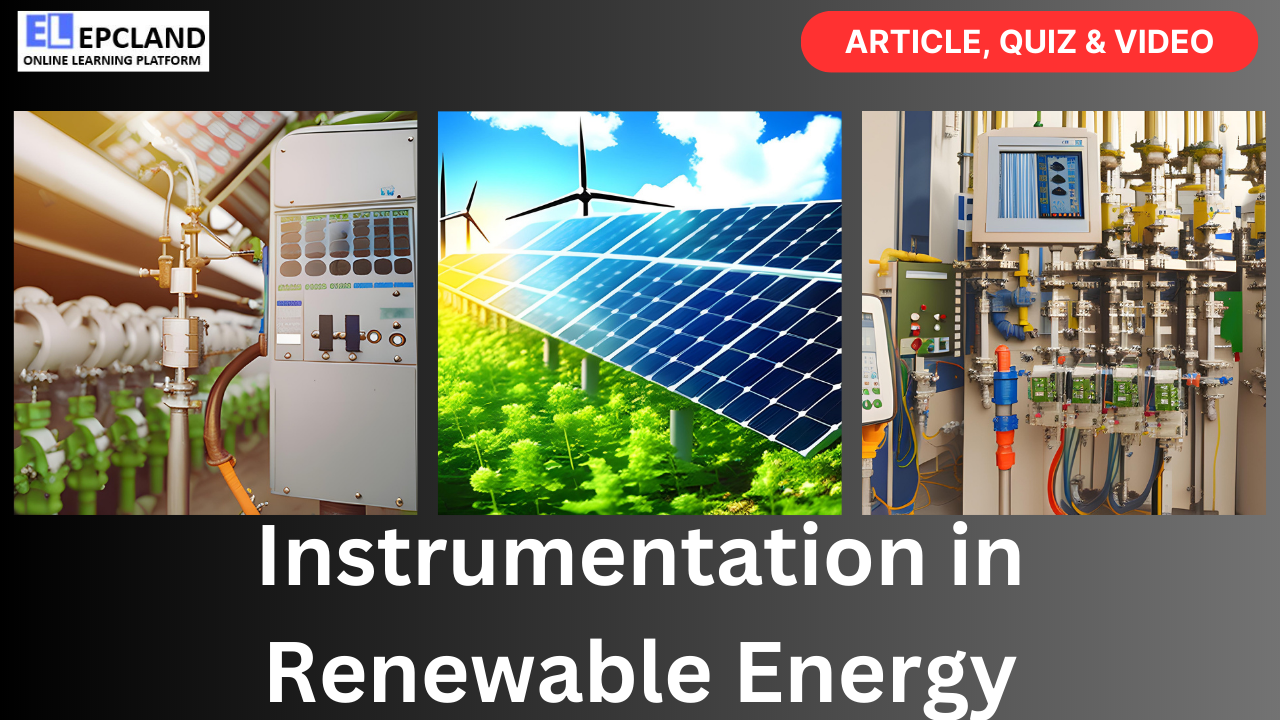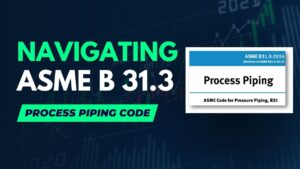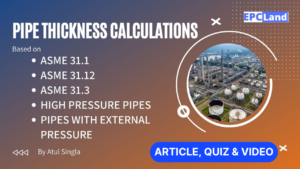The global shift towards renewable energy sources is more than a trend; it’s a critical response to the growing concerns over climate change and the finite nature of fossil fuels. Renewable energy technologies such as solar, wind, hydro, and geothermal power have gained momentum as clean and sustainable alternatives. Ensuring the efficiency, reliability, and safety of these renewable energy systems is paramount, and this is where Instrumentation and Control Engineering plays a vital role.
In this article, we will explore the fundamental role of instrumentation in renewable energy projects, the types of instruments used, their applications, and the challenges and innovations driving the industry forward.
Table of Contents
Do not miss the Complete Course on Piping Engineering
By EPCLand
The Importance of Renewable Energy
Before delving into the role of instrumentation, it’s essential to understand the significance of renewable energy sources in today’s world:
1. Environmental Benefits
Renewable energy sources produce little to no greenhouse gas emissions during energy generation. Unlike fossil fuels, they do not contribute to air pollution or climate change, making them a crucial part of mitigating environmental damage.
2. Energy Security
Renewable energy reduces dependence on finite fossil fuel resources, enhancing energy security. It diversifies the energy mix and reduces vulnerability to supply disruptions and price fluctuations.
3. Sustainable Development
Investing in renewable energy promotes sustainable development by creating jobs, fostering economic growth, and reducing social inequalities. It also supports the United Nations Sustainable Development Goals (SDGs).
4. Technological Advancements
Advancements in renewable energy technologies have made them more efficient and cost-effective. Instruments and control systems are instrumental in maximizing these technological gains.
Fundamentals of Instrumentation in Renewable Energy
Instruments in Renewable Energy
Instrumentation in renewable energy projects involves the use of sensors, controllers, and data acquisition systems to monitor, control, and optimize various aspects of energy generation. These instruments are essential for:
- Gathering data on energy production, environmental conditions, and system health.
- Ensuring safe and efficient operation.
- Implementing control strategies to maximize energy output.
- Diagnosing and mitigating faults and failures.
Principles of Measurement and Control
The principles governing measurement and control in renewable energy projects are similar to those in other industries, with an emphasis on accuracy, precision, and reliability. Key principles include:
1. Accuracy and Precision
Accurate measurement of variables like solar irradiance, wind speed, or temperature is crucial for predicting energy output and system performance. Precision ensures that measurements are consistently reproducible.
2. Range and Sensitivity
Instruments must operate within a specified range and possess sufficient sensitivity to detect small changes in the measured variables. For instance, wind speed sensors should cover a wide range of wind speeds and detect subtle fluctuations.
3. Calibration
Regular calibration ensures that instruments provide accurate measurements over time, compensating for any drift or wear. Calibration is especially critical in renewable energy systems where small measurement errors can lead to significant energy losses.
Types of Instruments in Renewable Energy
Different renewable energy technologies require specific instruments tailored to their unique characteristics:
1. Solar Photovoltaic (PV) Systems
Working Principle: Solar PV systems convert sunlight into electricity through the photovoltaic effect. Solar panels consist of semiconductor materials that absorb photons from sunlight, generating an electric current.
- Solar Irradiance Sensors: Measure incoming solar radiation to predict energy generation.
- Temperature Sensors: Monitor the temperature of solar panels for efficiency optimization.
- Inverters: Convert DC electricity from solar panels into AC electricity for grid connection.
2. Wind Energy Systems
Working Principle: Wind turbines capture kinetic energy from the wind and convert it into electrical energy. The rotation of turbine blades drives a generator, producing electricity.
- Anemometers: Measure wind speed, which directly impacts energy production.
- Wind Direction Sensors: Determine wind direction for optimal turbine alignment.
- Turbine Controllers: Regulate turbine operation based on wind conditions.
3. Hydroelectric Power Plants
Working Principle: Hydroelectric power plants use the gravitational potential energy of falling or flowing water to generate electricity. Water is typically released from a reservoir through turbines to generate power.
- Water Flow Sensors: Monitor water flow rates to calculate energy potential.
- Water Level Sensors: Measure water levels in reservoirs and rivers for flood control.
- Generator Controllers: Control the output of generators to match electricity demand.
4. Geothermal Energy Systems
Working Principle: Geothermal energy harnesses heat from the Earth’s interior. Heat is extracted from underground reservoirs and used to generate electricity through heat exchangers and turbines.
- Temperature and Pressure Sensors: Monitor underground conditions to optimize geothermal resource utilization.
- Pump Controllers: Regulate the flow of geothermal fluids through heat exchangers.
Applications of Instrumentation in Renewable Energy
Instrumentation and Control Engineering serve a wide range of critical applications in renewable energy projects:
1. Predictive Analytics
Instrumentation systems collect data on environmental conditions and energy production. Advanced analytics and machine learning algorithms use this data to predict energy output, identify trends, and optimize system performance.
2. Remote Monitoring and Control
Many renewable energy installations are located in remote or harsh environments. Instrumentation allows for remote monitoring and control, reducing the need for on-site personnel and improving safety.
3. Grid Integration
Integrating renewable energy sources into the electrical grid requires precise control and synchronization. Instruments ensure that energy generation matches grid demand and maintain grid stability.
4. Fault Detection and Maintenance
Instrumentation systems continuously monitor equipment health. They can detect anomalies or faults and trigger maintenance or shutdown procedures to prevent catastrophic failures.
Challenges and Innovations in Renewable Energy Instrumentation
1. Environmental Extremes
Renewable energy systems often operate in extreme environments, from deserts with scorching temperatures to offshore wind farms exposed to saltwater and harsh weather. Instrumentation must withstand these conditions to provide reliable data.
2. Data Volume and Analysis
The proliferation of sensors in renewable energy projects generates vast amounts of data. Managing, analyzing, and extracting actionable insights from this data is a significant challenge.
3. Cybersecurity
As renewable energy systems become more connected and reliant on digital control systems, they become susceptible to cyberattacks. Ensuring the cybersecurity of instrumentation and control systems is a growing concern.
4. Energy Storage
The intermittent nature of some renewable sources, such as solar and wind, necessitates effective energy storage solutions. Instrumentation is crucial in monitoring and controlling energy storage systems to optimize energy dispatch.
5. Emerging Technologies
Emerging technologies like blockchain and edge computing are being explored to improve the efficiency and reliability of renewable energy instrumentation systems.
Advantages and Disadvantages of Renewable Energy Technologies
Do not miss the Complete Course on Piping Engineering
By EPCLand
Let’s summarize the advantages and disadvantages of each renewable energy technology:
| Renewable Energy Technology | Advantages | Disadvantages |
|---|---|---|
| Solar Photovoltaic | – Clean energy source – Low operating costs – Minimal maintenance | – Intermittent energy generation – High upfront costs – Dependent on sunlight |
| Wind Energy | – Abundant and renewable – Low operating costs – Reduced greenhouse gas emissions | – Intermittent energy generation – Land and visual impact – Noise pollution |
| Hydroelectric Power | – Reliable and predictable – Low greenhouse gas emissions – Long operational lifespan | – Environmental impact (dams) – Limited suitable sites – Impacts aquatic ecosystems |
| Geothermal Energy | – Continuous and reliable – Low greenhouse gas emissions – Efficient and consistent output | – Limited geographic availability – High upfront drilling costs – Depletion of heat source |
Conclusion
Instrumentation and Control Engineering are indispensable in harnessing the full potential of renewable energy sources. They ensure that these technologies operate efficiently, reliably, and safely, contributing to a sustainable and clean energy future. As renewable energy projects continue to grow in scale and complexity, the role of instrumentation will become even more critical.
In this article, we’ve explored the importance of renewable energy, the fundamentals of instrumentation in renewable energy projects, the types of instruments used, and their applications. We’ve also discussed the challenges and innovations driving the industry forward.
Renewable energy holds the key to a greener and more sustainable future. With the right instrumentation and control systems in place, we can maximize the benefits of these technologies and accelerate the transition to a cleaner energy landscape.
FAQs
1. What is the role of instrumentation in renewable energy projects?
- Answer: Instrumentation in renewable energy projects involves the use of sensors, controllers, and data acquisition systems to monitor, control, and optimize various aspects of energy generation. It ensures safe and efficient operation, gathers critical data, and supports predictive analytics.
2. How do solar photovoltaic (PV) systems work, and what instruments are used in them?
- Answer: Solar PV systems convert sunlight into electricity through the photovoltaic effect. Instruments such as solar irradiance sensors, temperature sensors, and inverters are used to monitor solar radiation, panel temperature, and convert DC electricity to AC for grid connection.
3. What challenges do renewable energy instrumentation systems face in extreme environments?
- Answer: Renewable energy systems often operate in harsh conditions, like deserts or offshore locations. Challenges include maintaining instrument reliability, preventing corrosion, and ensuring accurate measurements despite extreme temperatures and weather.
4. How does instrumentation contribute to grid integration in renewable energy?
- Answer: Instrumentation ensures that energy generation from renewable sources aligns with grid demand and maintains grid stability. It helps manage power fluctuations and enables efficient integration of renewable energy into the electrical grid.
5. What are the advantages and disadvantages of various renewable energy technologies?
- Answer: Renewable energy technologies have unique pros and cons. For example, solar PV systems offer clean energy with low operating costs but are dependent on sunlight and have high upfront costs. Wind energy is abundant and renewable but can be intermittent and may impact landscapes and ecosystems. It’s important to weigh these factors when choosing a renewable energy source for a specific application.
Do not miss the Complete Course on Piping Engineering
By EPCLand
Recommended courses (Published on EPCLand)
- Basics of Piping Engineering
- Piping Layout Engineering
- Piping Material Engineering
- Piping Stress Analysis
- Complete Course on Piping Engineering
- Material Requisitions
- Piping Material Specifications
- Valve Material Specifications
Don’t miss the published articles on following:
| Data Analysis and Technology with Link | Data Analysis and Technology with Link |
| Data Analytics | Industrial Control Networks |
| Machine Learning | The Power of Acoustic Sensors |
Related Video
Attempt Quiz
Question 1:
What is the primary purpose of a wind speed sensor in a wind turbine?
Explanation: A wind speed sensor in a wind turbine is used to measure the velocity of the wind, which is crucial for optimizing power generation.
Question 2:
What type of sensor is commonly used to measure solar irradiance in photovoltaic systems?
Explanation: A pyranometer is commonly used to measure solar irradiance in photovoltaic systems, helping to assess the available solar energy.
Question 3:
Which instrument is essential for monitoring the performance of a geothermal heat pump system?
Explanation: Monitoring the performance of a geothermal heat pump system requires ground temperature sensors to assess the temperature of the earth for efficient heat exchange.
Question 4:
What does a hydrometer measure in the context of hydroelectric power generation?
Explanation: A hydrometer measures the density of water, which is important for determining water quality and its suitability for hydroelectric power generation.
Question 5:
What is the primary function of a data logger in renewable energy projects?
Explanation: The primary function of a data logger in renewable energy projects is to record and store environmental data, including measurements from various sensors, for analysis and monitoring.



